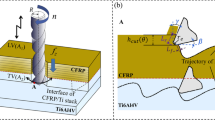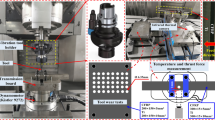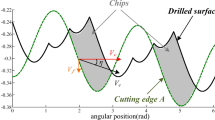Abstract
Carbon fiber reinforced polymers (CFRPs) are becoming increasingly prevalent in the industries including automobile, aerospace, and military due to their light quality, high specific strength, high corrosion resistance, excellent thermodynamics performance, etc. However, these excellent properties easily result in intensive tool wear, short tool life, and reduced machining accuracy. Although ultrasonic vibration–assisted drilling (UVAD) was considered an effective drilling method to reduce tool wear, most reported studies focused on machining kinematics or mechanics, and very few studies systematically explored the tool wear behaviors in UVAD of CFRP. To fill this gap, this paper aims to investigate tool wear of high-speed steel (HSS) twist drill in UVAD of CFRP and compares these wear behaviors with those in conventional drilling based on the experimental observation of the worn drill morphologies. The effects of cutting parameters on tool wear were discussed with the special focus on the differences in tool wear between conventional drilling (CD) and UVAD. The observed wear behaviors can include abrasion, adhesion, oxidization, or the combination of them. The introduction of UVAD can effectively reduce the average width of tool flank wear with a maximum reduction of 13.0% when compared with CD. Both increased feed rate and decreased spindle speed can lead to decreased tool wear. The findings in this paper might offer guidance on the selection of cutting parameters for extending tool life in UVAD of CFRP.










Similar content being viewed by others
References
Krishnaraj V, Prabukarthi A, Ramanathan A, Elanghovan N, Kumar MS, Zitoune R, Davim JP (2012) Optimization of machining parameters at high speed drilling of carbon fiber reinforced plastic (CFRP) laminates. Composites Part B 43(4):1791–1799
Alessandra C (2018) Machining of fibre reinforced plastic composite materials. Materials 11(3):442
Gara S, Fredj R, Naimi S, Tsoumarev O (2017) Prediction of cutting forces in slotting of multidirectional CFRP laminate. Int J Adv Manuf Technol 89:3379–3391. https://doi.org/10.1007/s00170-016-9161-8
Uriya Y, Yanagimoto J (2016) Suitable structure of thermosetting CFRP sheet for cold/warm forming. Int J Mater Form 9(2):243–252
Che D, Saxena I, Han P, Guo P, Ehmann KF (2014) Machining of carbon fiber reinforced plastics/polymers: a literature review. J Manuf Sci Eng 136(3):034001
Ameur MF, Habak M, Kenane M, Aouici H, Cheikh M (2017) Machinability analysis of dry drilling of carbon/epoxy composites: cases of exit delamination and cylindricity error. Int J Adv Manuf Technol 88(9-12):1–15
Raj DS, Karunamoorthy L (2016) Study of the effect of tool wear on hole quality in drilling CFRP to select a suitable drill for multi-criteria hole quality. Mater Manuf Process 31(5):587–592. https://doi.org/10.1080/10426914.2015.1004713
Karpat Y, Değer B, Bahtiyar O (2014) Experimental evaluation of polycrystalline diamond tool geometries while drilling carbon fiber-reinforced plastics. Int J Adv Manuf Technol 71(5-8):1295–1307. https://doi.org/10.1007/s00170-013-5592-7
Gaugel S, Sripathy P, Haeger A, Meinhard D, Bernthaler T, Lissek F, Kaufeld M, Knoblauch V, Schneider G (2016) A comparative study on tool wear and laminate damage in drilling of carbon-fiber reinforced polymers (CFRP). Compos Struct 155:173–183. https://doi.org/10.1016/j.compstruct.2016.08.004
Park KH, Beal A, Kim D, Kwon P, Lantrip J (2011) Tool wear in drilling of composite/titanium stacks using carbide and polycrystalline diamond tools. Wear 271(11):2826–2835
Rawat S, Attia H (2009) Wear mechanisms and tool life management of WC–Co drills during dry high speed drilling of woven carbon fibre composites. Wear 267(5-8):1022–1030. https://doi.org/10.1016/j.wear.2009.01.031
Fernández-Pérez J, Diaz-Alvarez J, Miguelez MH, Cantero JL (2020) Combined analysis of wear mechanisms and delamination in CFRP drilling. Compos Struct 255:112774. https://doi.org/10.1016/j.compstruct.2020.112774
Harris M, Qureshi MAM, Saleem MQ, Khan SA, Bhutta MMA (2017) Carbon fiber-reinforced polymer composite drilling via aluminum chromium nitride-coated tools: Hole quality and tool wear assessment. J Reinf Plast Compos 36(19):1403–1420. https://doi.org/10.1177/0731684417709359
Fernández-Pérez J, Cantero JL, Díaz-Álvarez J, Miguélez MH (2017) Influence of cutting parameters on tool wear and hole quality in composite aerospace components drilling. Compos Struct 178:157–161. https://doi.org/10.1016/j.compstruct.2017.06.043
Iliescu D, Gehin D, Gutierrez ME, Girot F (2010) Modeling and tool wear in drilling of CFRP. Int J Mach Tools Manuf 50(2):204–213. https://doi.org/10.1016/j.ijmachtools.2009.10.004
Xu J, Li C, Chen M, Ren F (2019) A comparison between vibration assisted and conventional drilling of CFRP/Ti6Al4V stacks. Mater Manuf Process 34(10):1182–1193. https://doi.org/10.1080/10426914.2019.1615085
Li C, Xu J, Chen M, An Q, El Mansori M, Ren F (2019) Tool wear processes in low frequency vibration assisted drilling of CFRP/Ti6Al4V stacks with forced air-cooling. Wear 426-427:1616–1623. https://doi.org/10.1016/j.wear.2019.01.005
Geng D, Zhang D, Xu Y, He F, Liu F (2014) Comparison of drill wear mechanism between rotary ultrasonic elliptical machining and conventional drilling of CFRP. J Reinf Plast Compos 33(9):797–809
Feng Q, Cong WL, Pei ZJ, Ren CZ (2012) Rotary ultrasonic machining of carbon fiber-reinforced polymer: feasibility study. Mach Sci Technol 16(3):380–398. https://doi.org/10.1080/10910344.2012.698962
Shan C, Zhang X, Dang J, Yang Y (2017) Rotary ultrasonic drilling of needle-punched carbon/carbon composites: comparisons with conventional twist drilling and high-speed drilling. Int J Adv Manuf Technol 98(1-4):189–200. https://doi.org/10.1007/s00170-017-1228-7
Makhdum F, Phadnis VA, Roy A, Silberschmidt VV (2014) Effect of ultrasonically-assisted drilling on carbon-fibre-reinforced plastics. J Sound Vib 333(23):5939–5952. https://doi.org/10.1016/j.jsv.2014.05.042
Wu CQ, Gao GL, Li HN, Luo H (2019) Effects of machining conditions on the hole wall delamination in both conventional and ultrasonic-assisted CFRP drilling. Int J Adv Manuf Technol 104:2301–2315
Faraz A, Biermann D, Weinert K (2009) Cutting edge rounding: an innovative tool wear criterion in drilling CFRP composite laminates. Int J Mach Tools Manuf 49(15):1185–1196. https://doi.org/10.1016/j.ijmachtools.2009.08.002
Madhavan V, Lipczynski G, Lane BM, Whitenton EP (2015) Fiber orientation angle effects in machining of unidirectional CFRP laminated composites. J Manuf Process 20:431–442
Ramirez C, Poulachon G, Rossi F, Msaoubi R (2014) Tool wear monitoring and hole surface quality during CFRP drilling. Procedia CIRP 13:163–168
Wang X, Kwon PY, Sturtevant C, Kim D, Lantrip J (2013) Tool wear of coated drills in drilling CFRP. J Manuf Process 15(1):127–135. https://doi.org/10.1016/j.jmapro.2012.09.019
Celik A, Lazoglu I, Kara A, Kara F (2015) Wear on SiAlON ceramic tools in drilling of aerospace grade CFRP composites. Wear 338:11–21
Liu D, Tang Y, Cong WL (2012) A review of mechanical drilling for composite laminates. Compos Struct 94(4):1265–1279. https://doi.org/10.1016/j.compstruct.2011.11.024
Henerichs M, Vos R, Harsch D, Kuster F, Wegener K (2014) Tool life time extension with nano-crystalline diamond coatings for drilling carbon-fibre reinforced plastics (CFRP). Procedia CIRP 24:125–129
Romoli L, Lutey AHA (2019) Quality monitoring and control for drilling of CFRP laminates. J Manuf Process 40:16–26. https://doi.org/10.1016/j.jmapro.2019.02.028
Matsumura T, Tamura S (2016) Temperature analysis in CFRP drilling. AIP Conference Proceedings 1769(1):080005. https://doi.org/10.1063/1.4963480
Zhu Z, He B, Chen J (2020) Evaluation of tool temperature distribution in MQL drilling of aluminum 2024-T351. J Manuf Process 56(1):757–765
Karpat YI, Değer B, Bahtiyar O (2012) Drilling thick fabric woven CFRP laminates with double point angle drills. J Mater Process Technol 212(10):2117–2127
Merino-Perez JL, Merson E, Ayvar-Soberanis S, Hodzic A (2014) The applicability of Taylor’s Model to the drilling of CFRP using uncoated WC-Co tools: the influence of cutting speed on tool wear. Int J Mach Mach Mater 16(2):95–112
Availability of data and material
All data generated or analyzed during this study are included in this article and its additional files.
Code availability
Not applicable.
Funding
The work described in this paper is supported by the Fundamental Research Funds for the Central Universities (Grant No: 2020-YB-025) and State Key Lab of Digital Manufacturing Equipment and Technology (Grant No: DMETKF2020026).
Author information
Authors and Affiliations
Contributions
Wenjian Huang: writing-original draft preparation, methodology. Shiyu Cao: investigation, formal analysis, resources. Hao Nan Li: investigation, reviewing and editing. Qi Zhou: investigation, validation. Chaoqun Wu: reviewing and editing, funding acquisition, conceptualization, supervision. Dahu Zhu: investigation, data curation. Kejia Zhuang: reviewing and editing.
Corresponding author
Ethics declarations
Conflict of interest
The authors declare no competing interests.
Additional information
Publisher’s note
Springer Nature remains neutral with regard to jurisdictional claims in published maps and institutional affiliations.
Rights and permissions
About this article
Cite this article
Huang, W., Cao, S., Li, H.N. et al. Tool wear in ultrasonic vibration–assisted drilling of CFRP: a comparison with conventional drilling. Int J Adv Manuf Technol 115, 1809–1820 (2021). https://doi.org/10.1007/s00170-021-07198-w
Received:
Accepted:
Published:
Issue Date:
DOI: https://doi.org/10.1007/s00170-021-07198-w




